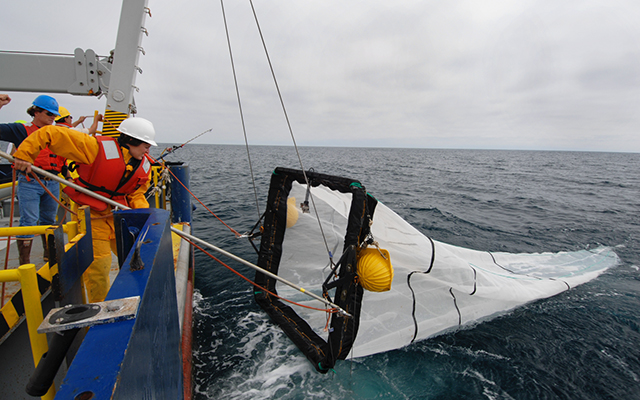
NOAA Selects UC San Diego for Cooperative Institute to Study Marine, Earth and Atmospheric Systems
Selection awards $220 million over five years
Published Date
By:
- Lauren Fimbres Wood
Share This:
Article Content
The National Oceanic and Atmospheric Administration today announced it selected the University of California San Diego to host the new Cooperative Institute for Marine, Earth, and Atmospheric Systems (CIMEAS).
The cooperative institute, led by Scripps Institution of Oceanography at UC San Diego, will conduct collaborative, multidisciplinary research on climate, oceans, and ecosystems to better understand the coupled systems and assess the physical and biological state of the oceans. CIMEAS will advance regional, national, and global understanding of natural and human-caused impacts on ecosystems and the sustainable ways to strengthen our environmental and economic well-being.
“UC San Diego is the perfect home for CIMEAS,” said UC San Diego Chancellor Pradeep K. Khosla. “The university has long been at the forefront of interdisciplinary research to understand and protect the planet with research partners from across the globe. This new institute will help advance our scientific understanding of how our planet is changing and how we can conserve and manage our most precious resources.”
The selection of UC San Diego, made through an open competitive evaluation, comes with an award of up to $220 million over five years, with the potential for renewal for another five years based on successful performance.
The new cooperative institute, in partnership with NOAA and other agencies, will conduct and coordinate innovative research in four main areas, focusing on the western United States, the California Current, and the Pacific and Southern oceans. The science will support ecosystem-based management of living marine resources; research, development, and technology innovation for global ocean observations and monitoring, coastal and oceanic observations, analysis, and prediction; and weather, water, and climate research.
“Scripps Institution of Oceanography brings together ocean observing systems with both regional and global scope, modeling expertise that adds new dimensions to our ability to predict the ocean, and ocean insights built on more than 100 years of exploration,” said Margaret Leinen, vice chancellor of marine sciences at UC San Diego and director of Scripps Oceanography. “This expertise along with powerful partnerships with West Coast universities, local, regional, state, national and international governments, businesses and non-profits will generate the kinds of insights that NOAA needs to ensure a sustainable future for the ocean.”
CIMEAS will also support sustained observation programs in marine ecological systems and global climate. Among them are iconic long-term studies like the 70-year California Cooperative Oceanic Fisheries Investigations (CalCOFI), the Mauna Loa Observatory at which atmospheric carbon dioxide concentrations are measured, the Argo international network of global ocean profiling floats, and more.
“CIMEAS is home to many vital long-term observation programs that lay the foundation for understanding our complex earth system, and we’re proud of our long-standing partnership with NOAA on many of these programs,” said research oceanographer Bruce Cornuelle, director of the new institute. “Through CIMEAS, we look forward to helping improve the scientific understanding of the ocean, Earth, and atmosphere for the benefit of the public, and training the next generation of diverse scientists through collaborations with our partner institutions.”
In addition to UC San Diego, the institute will include Humboldt State University, Cal State University Los Angeles, the Farallon Institute, Moss Landing Marine Labs managed by San Jose State University, University of California Davis, University of California Los Angeles, University of California Santa Barbara, and University of California Santa Cruz.
“CIMEAS will continue to develop and extend our strong collaboration with the National Marine Fisheries Service Southwest Fisheries Science Center, ” said Daniel Costa, the director of the Institute of Marine Sciences at UC Santa Cruz. “This program will support critical research into the factors that regulate fisheries along the West Coast of the U.S. It will support graduate students and postdocs as our nation's workforce to understand the role of climate in fisheries management.”
The range of partner institutions bring significant expertise, facilities, and capabilities to the institute, and will expose NOAA to diverse talent, technology, and ideas.
“Moss Landing Marine Laboratories (MLML) is excited to join the new CIMEAS organization because it provides extraordinary opportunities for our students and researchers to collaborate on important marine research and aquaculture issues,” said MLML Director Jim Harvey. “Our graduate students will benefit greatly by collaborating with NOAA scientists and others to investigate relevant oceanographic problems and to gain important skills as they become the leaders and researchers of the future.”
NOAA supports 17 cooperative institutes consisting of 57 universities and research institutions in 23 states and the District of Columbia. These research institutions provide strong educational programs that promote student and postdoctoral scientist involvement in NOAA-funded research.
“Our cooperative institutes are a vital component of NOAA’s mission to address emerging scientific issues and train the next generation of researchers,” said Craig McLean, assistant NOAA administrator for Oceanic and Atmospheric Research. “This institute will help NOAA achieve our mission to better understand the ocean and atmosphere, which depends on research, data and information to make sound decisions for healthy ecosystems, communities and a strong blue economy.”
Share This:
You May Also Like
Stay in the Know
Keep up with all the latest from UC San Diego. Subscribe to the newsletter today.



